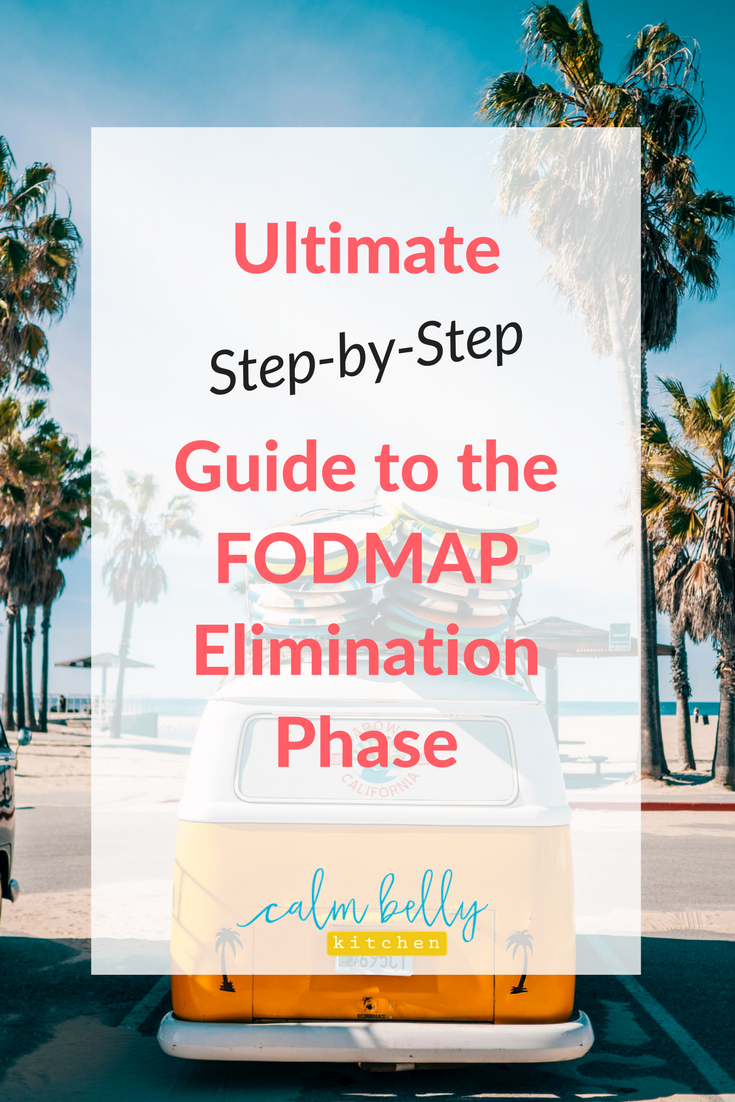Ultimate Step-By-Step Guide to the FODMAP Elimination Phase
Save it on Pinterest!
The story usually goes something like this…
You learn about the FODMAP Diet from a doctor, and it sounds great! There’s a way to control IBS with diet alone and research shows it really works.
But hang on...you can’t eat what!?
Since you likely received little or no guidance, you’re off to search the internet. And that’s when things start looking hopelessly complicated.
Can you relate?
From conversations with the CBK community, I know you’re tired of piecing together incomplete bits of information. That’s why I wrote this Ultimate Guide.
It’s not just about what you can and can’t eat. That’s important, but it’s only one piece of what you need to feel better as quickly as possible.
To get the best results from the FODMAP Diet, you need a well-rounded approach AND a plan to follow. The framework below is your step-by-step plan!
If you’re just starting to explore whether the FODMAP Diet is for you, here are the essential facts:
The goal of the diet is to help you understand your unique IBS triggers and control your symptoms.
It doesn’t cure IBS, but it can make life a LOT better.
Research suggests up to 86% of people experience improvement in their symptoms from the FODMAP Diet.
Most studies focus on FODMAP for people with IBS, but it’s sometimes recommended for people with SIBO, Crohn’s disease, colitis, and other functional GI disorders.
(If you’re brand, brand new to the FODMAP Diet, give this post a read to learn the fundamentals!)
Perhaps the most important thing to know up front is that the FODMAP Diet is NOT intended to be a lifetime diet.
Instead, it’s a learning diet with two distinct phases:
FODMAP Elimination Phase - You dramatically reduce your intake of high-FODMAP foods to confirm your sensitivity to FODMAPs and reach your optimal level of symptom control. This phase typically takes 4-8 weeks.
Reintroduction Phase - You strategically bring back high-FODMAP foods to learn your unique tolerance level for the different categories of FODMAPs. Most people can enjoy a wide variety of food while keeping IBS symptoms in check.
The exact length of each phase can vary--What's important is learning what works for your body and achieving the goals of each phase.
When you complete BOTH phases you know what foods to avoid and what foods don’t trigger your symptoms. You’re in control of how your belly feels without resorting to extreme food restriction.
The FODMAP Diet can seem overwhelming at first, but gaining control over your symptoms is SO worth it.
With the 10-Step framework below, you’ll be able to get the hang of it QUICKLY so you can see the results for yourself!
Step 1: Understand the Goal of the Elimination Phase
Your job in the elimination phase is to confirm that you are indeed sensitive to FODMAPs. The happy side effects of this are 1) understanding what impacts your IBS and 2) feeling better than ever.
Here are the goals of the FODMAP Elimination Phase in detail:
Learn how your body feels without FODMAPs (your maximum level of symptom control)
Discover the other factors that contribute to your IBS symptoms and learn to manage them
Give your body a clean slate so you can bring foods back and create your unique lifetime eating style in the Reintroduction Phase
Most people spend 4 to 8 weeks in this phase, but it can vary. Keep in mind that it may take a couple weeks to get used to the FODMAP Diet so that you're eating the correct foods and portion sizes. No need to rush it.
Step 2: Download the Monash FODMAP App
Scientists at Monash University in Melbourne developed the FODMAP Diet, and their app is the largest FODMAP food database available. Since their studies into IBS and diet began as recently as 2005, there’s still a lot to learn.
Monash is regularly testing new foods for FODMAP content and updating the app with the latest info. Since the university is not a for-profit organization, sales from the app help fund research and food testing. The app costs $7.99, but don’t let the price deter you.
Here’s why the Monash app is an essential tool:
It displays FODMAP content by serving size. Many FODMAP-containing foods--including some that end up in the “don’t eat” column on other lists--CAN be eaten during the elimination phase in the appropriate serving sizes.
It’s the largest and most reliable source of FODMAP food data, but it also has features like filtering, a food diary, and 80 recipes with shopping lists.
Your purchase supports FODMAP research--All profits from the app support continuing study!
Step 3: Get to Know High and Low FODMAP Foods
You’ve the got the app, right? Now go through the food categories and make a list of everything you CAN eat (seriously, get out a notebook and write ‘em down).
But don’t just create a random list--Focus on foods you already know and like, as well as a few new ones you’d be willing to add to your diet. You’re going to end up with a fairly long list! Jot down a few meals you could make with these foods.
Need a shortcut? Download my Low-FODMAP Diet Shopping List. Each underlined food is a link to a recipe on the CBK blog featuring that food. Suddenly, you’ve got a ton of possibilities.
Step 4: Create Go-To Meals
Go-to meals have just three requirements:
They're simple to make.
The ingredients are easy to pick up or keep on hand.
Eating them makes you happy.
Now use the list you made in Step 3 or the handy shopping list to brainstorm 2 or 3 ideas. Then imagine simple variations on those ideas. For example:
Replace bell pepper with eggplant in a stir fry
Use rice noodles instead of rice
Swap shrimp for salmon.
When it comes to creating new meals for the FODMAP diet, don’t try to reinvent the wheel. Adapt meals you already enjoy. You don’t need to cook a brand new recipe every night unless that’s what you enjoy doing! Simple is beautiful.
Having said that, we all need a little inspiration. Here are some places to find meal ideas:
Pinterest - It’s a search engine, and the number of low-FODMAP recipes seems to grow everyday
Calm Belly Kitchen blog - Go to this page to start browsing
Cookbooks - There are a few great low-FODMAP books on the market, including (shameless plug) the Calm Belly Kitchen Cookbook
Step 5: Become a Supermarket Sleuth
Get in the habit of reading food labels. Specifically, look for any sneaky high-FODMAP ingredients that might not be obvious on first glance.
Here are the 3 most common offenders:
Sugar alcohols - Xylitol, mannitol, sorbitol, maltitol, isomalt are all high in polyols. They’re found in both foods and medications.
Inulin/chicory - Called by both names, this dietary fiber is used in many processed foods to improve texture.
Natural Flavor - This term refers to food products, often in the form of extracts or essential oils, used primarily for flavor rather than nutrition. In many foods onion and garlic can fall under this term, so it’s best to avoid products that list “natural flavor” in most cases.
Step 6: Set Up Your Food & Symptom Journal
Tracking your data is essential during the elimination phase for a few reasons:
Symptoms can appear up to 48 hours after eating a high-FODMAP food. Having the ability to look back over your meals will have you decoding any symptoms faster.
A log of your food and symptoms lets you find patterns and spot non-FODMAP irritants. For instance, you’ve been bloated lately and notice that it’s typically on days when you drink diet Coke. Maybe carbonated beverages are to blame.
Tracking keeps you focused on sticking to your low-FODMAP plan.
Choose any tracking method you’ll use consistently: a notebook, a Word/Google doc, or an app.
Step 7: Make a Stress Management Plan
A variety of non-food factors play a role in your digestion, with stress having the biggest impact. A stress response in your brain directly affects your gut. You know that feeling of “butterflies” in the pit of your stomach--They’re caused by stress.
Practice regular relaxation or stress reduction in your daily routine. From watching hilarious cat videos, to exercising, to meditating, all the tactics work. Find the one that feels good for you.
Step 8: Create a Dining Out Plan
It’s hard to avoid meals out, and there’s no need to stay barricaded in your house while you do the FODMAP Diet. The way to have a good experience is to be prepared.
Frequent restaurant goers may have to reduce the frequency. For example, if you eat lunch out every weekday, cut back to 2 days a week. Otherwise, creating a simple plan for going to restaurants is the key to avoiding FODMAPs and feeling great when the meal’s over.
Dining out strategies to try:
If you can pick the destination, research menus online to find the most FODMAP friendly.
Call ahead and speak to the manager about your options.
Check out the menu and have 2 or 3 dishes in mind so you know what questions to ask your server on the spot.
Step 9: Check In on Your Progress
Many people start seeing fewer and less severe symptoms in 1 to 4 weeks. Why the range? It’s very common to spend the first week or two getting used to a new way of eating, shopping, and cooking.
Getting help from an expert or support group can speed up your results--I aim to get clients done in 6 weeks--but 8 to 12 weeks is typically the ideal amount of time to achieve the goals of the elimination phase (see Step 1).
You also need to assess your progress along the way. Here’s when I recommend checking in with yourself:
4 weeks in: Do you have a good rotation of meals? Are you compliant with the diet or are you getting stuck? How much symptom improvement have you noticed?
6 weeks in: Ask the same questions as week 4.
8 weeks in: If you’ve stuck with the diet, you should notice at least a 50% improvement in your symptoms. Some people will feel 70, 80, or 95% better. It will vary, but any of these numbers is a meaningful difference!
Step 10: Move onto Phase 2 When You’re Ready (but don’t wait too long)
Here’s how you know it's time move from the Elimination Phase to the Reintroduction Phase:
You have consistent improvement in your symptoms
You’ve recognized how stress and other lifestyle factors impact your digestion
You’ve gotten comfortable eating a low-FODMAP Diet
Read more about when you’re ready to reintroduce FODMAPs in this post.
When you reach this point (woohoo!), it’s time to start the reintroduction phase--You bring back high-FODMAP foods strategically to discover your personal tolerance level for each FODMAP category.
When you’re ready to start reintroduction, there’s the danger of getting stuck in “elimination limbo.” That’s when you know it’s time identify your IBS triggers but the anxiety about eating food that might give you symptoms holds you back.
This fear is common, nearly everyone experiences it. Remember the ultimate goal of the FODMAP Diet: To identify your IBS triggers so you can have the maximum level of symptom control AND the most variety in your diet.
Conclusion
The 10 steps in this post are the essential actions you need to relieve symptoms FAST and get the greatest return for your effort.
Remember, it's not just about banning a list of foods if you want to experience the greatest improvement in IBS symptoms.












